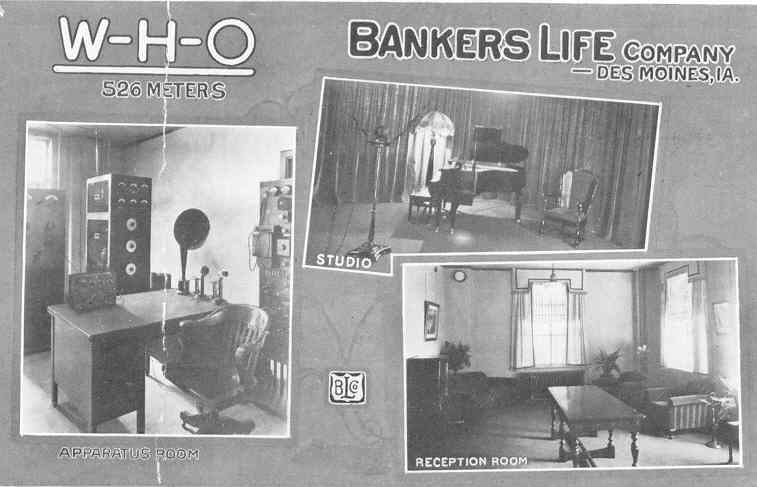
WHO, Des Moines, began operations in April 1924 on 570 kHz with 500 watts. The station was owned by Bankers Life, an insurance company which is now known as The Principal. Company president, George Kuhns, promoted creation of the station.
- Studios and transmitter were on the top floor of the Liberty Building at 418 Sixth Avenue in downtown Des Moines.
Kuhns chose the call letters WHO because at the time people searching the radio dial for stations would ask, "Who is it?"
- WHO would identify itself during Bankers Life ownership as, "This is WHO - Who? - Banker's Life, Des Moines."
- The song Who from the musical "Sunny" was used as a theme for the station.
- Power was increased to 1,000 watts, and then, to 5,000 watts. Based upon incomplete records it appears that these power increases occurred in 1925.
- WHO became an NBC network affiliate on September 27, 1927. By this time the station was broadcasting from 6:00 AM until Midnight.
In 1928 following creation of the Federal Radio Commission by the United States Congress, WHO was ordered to share the frequency of 1000 kHz with WOC, Davenport. WOC was owned by the Palmer College of Chiropractic, and it was the first commercial station in the state of Iowa. Both WHO and WOC protested the marriage, but the Federal Radio Commission ordered the two stations to share time on 1000 kHz, each with 5,000 watts, effective November 11, 1928. 1000 kHz is one of the eight clear channels assigned to Zone 4 under the FRC plan and other regulations.
- For about a year the two stations would alternate portions of the broadcast day. One week WHO would be on during the day; WOC would be on at night. The next week, the stations would operate on an opposite schedule.
- Bankers Life left the broadcasting business in 1930 when it sold WHO to Central Broadcasting Company, an entity formed by B.J. Palmer and several associates to acquire WHO.
During the early years of control of WHO by the Palmer interests, experimentation was conduct to allow synchronous operation of the two stations. Telephone lines connected the WHO and WOC transmitters. Modifications were made to the transmitters to improve frequency stability. The two stations were on the air at the same time, broadcasting the same programs. There was a serious problem with synchronous operation, however. Neither station could be heard in an area about 30 miles wide half way between Des Moines and Davenport.
While experiments continued with synchronous operation, Central Broadcasting Company on October 7, 1930, applied for a construction permit to build a 50,000 watt transmitting plant. The construction permit was granted November 17, 1931, but the location for the new transmitter was not specified. On February 10, 1932, another construction permit was granted, authorizing a 50,000 watt transmitter for stations WHO-WOC at Mitchellville, Iowa.
In April 1932 the WHO studios moved from the Liberty Building to new facilities on the second floor of the Stoner Building at 914 Walnut Street. Construction began on the Mitchellville transmitter site. Work would take about a year.
On April 22, 1933, the 50,000 watt transmitter went on the air from the Mitchellville site. The transmitter was connected to a wire antenna which stretched about 750 feet. The antenna wire was supported by two 300 foot towers.
In May 1933 the WOC studios in Davenport are closed, and personnel from Davenport move to Des Moines. Among the persons coming from Davenport to Des Moines are sportscaster/announcer Ronald Reagan. The station is identified as WHO-WOC until November 11, 1933 (WOC returns to the air as a separate station in November 1934).
Pictures of Palmer/WOC building in Davenport 1939 and 1956.
Aug 31 03
The wire antenna system was replaced with a vertical radiator manufactured by Blaw Knox November 23, 1934. The Blaw Knox tower had a distinctive diamond shape and was 532 feet tall.
- An application for experimental operation of WHO at 500,000 watts was made in December 1935. The application was dismissed in May 1938.
- Beginning in July 1937 WHO was authorized to transmit photographs by facsimile. The experiment continued until August 1940 when it was discontinued. While the process was technically successful, it did not produce revenue.
WHO moved to its familiar 1040 kHz frequency on March 29, 1941. This was part of a general realignment of radio stations in the United States, required to comply with provisions of the North American Radio Agreement.
In 1950 a new Westinghouse 50,000 watt transmitter was installed to replace the RCA transmitter which began service in 1933. A new tower, designed by WHO engineers, was erected. The tower is a modified Franklin design. The tower is grounded at the base and insulated at approximately 390 feet (about half way). Each section of the tower is fed by the transmission line. The design is intended to maximize the ground signal and reduce nighttime fading. The tower is 780 feet tall, and at one time it was the tallest structure in Iowa. The tower continues to be used to broadcast WHO's 50,000 watt signal from "coast to coast, border to border, and then some." (phrase used on Country Music USA which was on WHO from 10:30 PM until 5:00 AM during the 1960s, 1970s, and early 1980s). The tower is now fed from one of two solid state Harris 50,000 watt transmitters. The Westinghouse transmitter is still in place and could be made operational by re-attaching the transmission line to the antenna.
DesMoinesBroadcasting.com home page